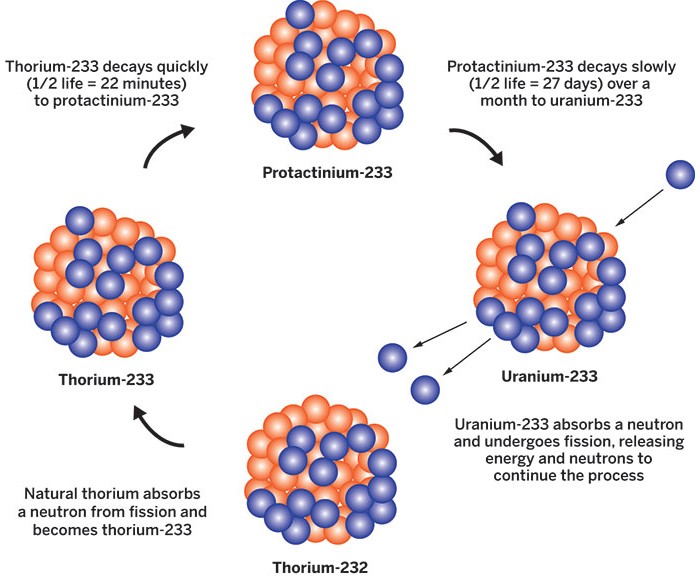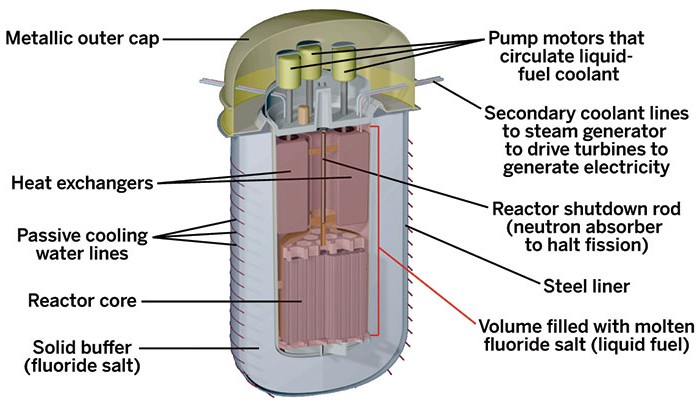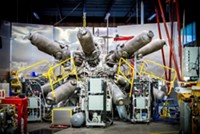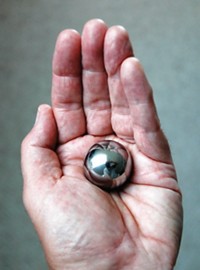Advertisement
Grab your lab coat. Let's get started
Welcome!
Welcome!
Create an account below to get 6 C&EN articles per month, receive newsletters and more - all free.
It seems this is your first time logging in online. Please enter the following information to continue.
As an ACS member you automatically get access to this site. All we need is few more details to create your reading experience.
Not you? Sign in with a different account.
Not you? Sign in with a different account.
ERROR 1
ERROR 1
ERROR 2
ERROR 2
ERROR 2
ERROR 2
ERROR 2
Password and Confirm password must match.
If you have an ACS member number, please enter it here so we can link this account to your membership. (optional)
ERROR 2
ACS values your privacy. By submitting your information, you are gaining access to C&EN and subscribing to our weekly newsletter. We use the information you provide to make your reading experience better, and we will never sell your data to third party members.
Nuclear Power
Trying To Unleash The Power Of Thorium
Proponents aim to tap vast nuclear energy potential of obscure natural resource
by Mitch Jacoby
July 6, 2015
| A version of this story appeared in
Volume 93, Issue 27

John H. Kutsch never planned to be the world’s number one proponent of nuclear energy from thorium. The cause found him.
“A company hired us to study a large number of materials from all across the periodic table,” to look for possible investment opportunities, relates Kutsch, president of Whole World, a Chicago-area product engineering and design consultancy. Thorium was on the list.
After coming up to speed on thorium’s uses—the oxide was once widely used to make mantles for gas lanterns, and some thorium compounds are still used today as catalysts for petroleum cracking and sulfuric acid synthesis—Kutsch gave his assessment to the client. “Thorium is basically garbage,” he said, adding casually, “but it might just save the world.”
The afterthought came from information Kutsch gleaned by studying thorium’s history and from scrutinizing various nuclear energy websites and discussion boards. Although the element has little commercial use today, decades earlier people had recognized its potential for use in nuclear energy.
Studies conducted in the early days of the U.S. nuclear industry showed that thorium could be used as a precursor for nuclear fuel to run electricity-generating power plants. And the element, number 90 in the periodic table, offered numerous potential advantages in safety, cost, and environmental waste relative to uranium, which was another candidate to power commercial nuclear reactors. As history played out, uranium-fueled nuclear power became the standard, and except for a successful multiyear experiment at Oak Ridge National Laboratory (ORNL) in the 1960s, little was done with thorium. So it was largely forgotten.
But after learning about the nearly inexhaustible untapped energy potential of thorium, Kutsch concluded that the element could help satisfy growing global energy needs. He and other thorium enthusiasts are now spurring businesses and governments to tap into thorium’s potential.
Thorium boasts several advantages over uranium, and the element’s supporters call attention to them loudly. First, thorium is three to four times as abundant as uranium and potentially less expensive to process. A few grams of thorium could also produce enough energy to power an average American’s life for a decade. The element could do this without generating material useful for making weapons, which sidesteps concerns about nuclear proliferation.
Thorium At A Glance
Natural Th: ~100% 232Th
Abundance in Earth’s crust relative to uranium: 3–4 times as great
U.S. reserves: ~400,000 metric tons, could produce same energy as ~ 1 trillion barrels of crude oil
World reserves: ~1.9 million metric tons
Mass needed to generate electricity needs of typical American for one decade: ~1/2 oz
There are environmental benefits as well. Compared with coal- and natural-gas-fired power plants, thorium-fueled plants, like other nuclear plants, would not emit greenhouse gases, while generating power almost continuously, unlike solar- and wind-driven systems. And although thorium fuel would produce radioactive waste, its radiotoxicity would persist for just tens to hundreds of years rather than thousands of years, as is the case with uranium waste.
Finally, thorium comes with safety benefits, its proponents claim. So-called molten salt reactors can use thorium as a liquid fluoride salt, which offers pressure and heat management advantages over today’s solid-fuel comercial reactors.
One design for a molten salt reactor calls for surrounding a fluid core containing 233UF4 in a lithium-beryllium fluoride solvent with a molten blanket of 232ThF4 in the same solvent. The thorium is not actually the nuclear fuel. It is converted to the fuel, 233U, when exposed to low-energy neutrons. As 233U nuclei in the core fission, they generate heat that is transferred to a gas that drives a turbine to generate electricity. At the same time, the uranium nuclei emit neutrons that convert 232Th in the blanket to 233U. As uranium fuel accumulates in the blanket, it gets converted to UF6 gas, separated, and fed into the core gradually and continuously as fresh thorium is injected into the blanket.
An advantage of this design is that unlike most of today’s commercial uranium reactors, molten salt reactors would operate at low pressure and there is no chemical driving force that could lead to a dangerous buildup of hydrogen gas, says David LeBlanc, president and chief technology officer at Terrestrial Energy, an Oakville, Ontario-based start-up commercializing molten salt reactors. Further, because the fuel is liquid, the reactor’s heat source is mobile and easily controlled, unlike the case with solid fuels. In addition, if the reactor leaked or was drained of its fuel, the molten salt would cool and solidify. In the event of reactor malfunction, this would terminate nuclear reactions and prevent the spread of radioactive material without the need for plant operator intervention.
So if thorium is safer than uranium and its nuclear energy potential was recognized decades ago, why has it taken people so long to start advocating for its use? Some nuclear aficionados suggest that when Cold War-era policy-makers chose to pour major funds into developing fuel for nuclear power reactors, they favored uranium, for which technology and know-how were more advanced than thorium. Others contend that U.S. leaders at that time were more interested in uranium reactors because they are better suited to breeding plutonium isotopes that were needed for making nuclear weapons. Over time, pressurized light-water reactors became the standard, and because they are fueled by uranium, thorium was left behind and has never been commercialized.

To try to put it back on the nuclear power menu, Kutsch formed the Thorium Energy Alliance (TEA), a nonprofit advocacy organization dedicated to educating government leaders and the public about thorium energy’s merits. He then quickly organized TEA’s first thorium energy conference, which was held in Washington, D.C. That was 2009. Last month, in Palo Alto, Calif., TEA held its seventh conference.
Progress during that period has come in small increments, but the word about thorium is certainly spreading. For example, a European group with the same goals as the U.S.-based alliance formed the International Thorium Energy Organisation, IThEO. This group will convene its fifth conference this fall in Mumbai, India, which along with China and Norway is one of the few countries actively pursuing a thorium nuclear program. Both organizations’ conferences have grown, though they remain small—a couple hundred participants at each. But unlike the first conferences, the meetings now draw many nuclear engineers, materials scientists, and other technical specialists, as well as venture capitalists and other investors.
In the past five years, thorium has also taken small steps forward in business and government circles. For example, a few start-up companies have been launched and are working to develop molten salt nuclear reactors. And in a small way, thorium has also made inroads on Capitol Hill in recent years. After numerous lobbying trips to Washington, D.C., Kutsch and James C. Kennedy succeeded in getting thorium-related initiatives included in several recent congressional bills. Kennedy is president of ThREE Consulting and a mining specialist with expertise in thorium and rare-earth minerals, which tend to be intermingled geologically. The proposed bills, which were not passed, would have created a cooperative consortium capable of refining rare-earth minerals and separating and storing thorium for energy research and development.

But support for thorium-based nuclear energy isn’t unanimous. Arjun Makhijani, a nuclear physicist and president of the Institute for Energy & Environmental Research, a Maryland-based science and environmental organization, counters a number of claims made by thorium supporters. For example, Makhijani contends that radioactive fluoride waste from thorium reactors will require expensive processing that involves risk of contamination and pollution.
And with respect to nuclear proliferation, Makhijani argues that molten salt reactors using thorium would be “much more vulnerable” than today’s commercial uranium reactors. He explains that the process that converts thorium to 233U proceeds by way of 233Pa, which has a 27-day half-life. A country that does not have the nuclear materials needed to make nuclear weapons, such as 233U, could separate out the 233Pa from a reactor and then let it decay to the needed uranium isotope, he says. Thorium proponents counter that to carry out such a scheme, that country would need to develop protactinium separation and processing technology and apply it at home or commandeer other countries’ nuclear facilities.
Moving forward with any new thorium reactor design will require major investments of time, effort, and money before a regulatory agency will grant a license for commercial operation. With this in mind, companies have adopted various design strategies.
Terrestrial Energy, for example, aims to speed the regulatory process and win public acceptance with a molten salt reactor design in which the primary reactor vessel is a permanently sealed system that houses the reactor core and the main heat exchangers. The unit would not need to be opened for repairs or refueling during its operating lifetime. Instead, plants would simply replace the reactors periodically and then let the old ones cool, thereby eliminating the risk of hazardous material escaping to the atmosphere. LeBlanc noted that the reactor could be fueled with fluoride salts of thorium or uranium blended with other fluorides.
ThorCon Power, another start-up developing molten salt reactors, also aims to move quickly. The company proposes to build scaled up versions of the 1960s ORNL reactor using shipyardlike assembly-line methods. That approach would enable ThorCon to mass-produce reactors that can be shipped modularly and assembled quickly. The proposed reactor design uses a mixture of sodium, beryllium, uranium, and thorium fluorides.
Another way to put thorium to use quickly is to use the metal to make fuels for today’s commercial reactors. That’s what McLean, Va.-based Lightbridge is doing with its “seed and blanket” design. These solid-fuel-rod assemblies appear identical to commercial ones used today but have a unique composition. Seed rods at the center of the assembly are made of a metallic uranium-zirconium matrix. Blanket rods positioned along the periphery contain thorium-uranium oxide pellets. As with the molten salt design, uranium fission generates heat and converts 232Th to 233U, thereby creating more fuel.
Lightbridge also has a preliminary design for a fuel with the same thorium-uranium oxide blanket but using a metallic plutonium-zirconium seed. This fuel offers an effective way to consume plutonium stockpiles created as waste from current light-water reactors. For the same reasons, Thor Energy, based in Oslo, Norway, also uses thorium together with plutonium in solid-fuel assemblies.
These business developments have been crucial in raising thorium’s profile slightly. But one academic development may be even more significant. Last month at the TEA conference, Thomas J. Dolan, a professor of nuclear engineering at the University of Illinois, Urbana-Champaign, announced that the first textbook on molten salt reactors and thorium fuel was nearly completed and would be published next year. Dolan and others think that the book and associated curriculum could help train the next generation of students pursuing nuclear science and engineering in the logic behind thorium reactors.
“The human supply chain is probably the most critical thing,” Kutsch told attendees at last month’s conference. “If we built a molten salt reactor today, who would run it?”
Dolan, Kutsch, and other proponents hope to inspire those future plant operators through their efforts. “I don’t have a dog in the race,” Kutsch said. “I’m doing it because it’s the right thing to do.”




Join the conversation
Contact the reporter
Submit a Letter to the Editor for publication
Engage with us on Twitter